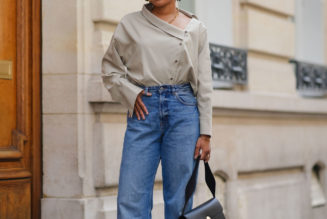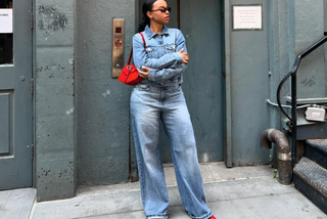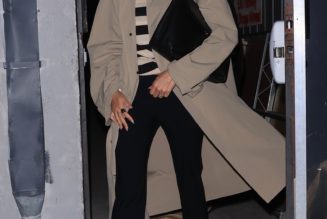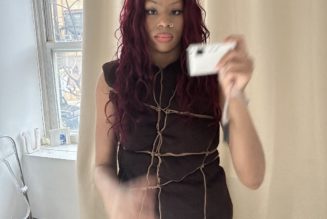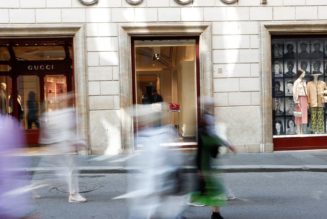The pandemic was a period of mass unemployment and economic hardship for many Americans. It was also a riotously popular time for buying luxury goods.
“2021 and 2022 were blockbuster years for the luxury industry,” says Lauren Sherman, fashion correspondent at Puck News. “The biggest years they’ve ever had — ever.”
Shoppers devoured designer leather handbags, limited-edition sneakers, classic watches, and holy grail prestige beauty products that went viral on TikTok; practically every type of luxury brand saw its sales swing up during the pandemic. Part of the explosion is due to the fact there’s a lot more upscale stuff to buy. Luxury was once confined to traditional categories such as clothing, accessories, wines, and cars. No longer. In the past few years, there’s also been an insatiable appetite for high-end kitchenware and other home goods — a $420 Le Creuset dutch oven, a $1,500 Breville espresso maker, a $1,500 Thermomix blender, a $110 Aesop candle smelling of vetiver, frankincense, and wealth.
Analysts have a nebulous definition of what constitutes a luxury good, but it’s usually an object that not only has a sky-high price but also promises quality craftsmanship and an air of exclusivity. It shouldn’t be something everyone has. Yet more and more Americans across ages and income brackets are getting swept up in the world of extravagant products, driving the industry to an incredible boom.
Moët Hennessy Louis Vuitton — LVMH for short — this year became the most valuable luxury company in the world, surpassing a market cap of a half trillion dollars in April. The owner of brands such as Dior, Givenchy, and Tiffany, it now floats in the uppermost stratosphere of the world’s biggest companies, among names like Meta, Tesla, Berkshire Hathaway, and Amazon. This year, Bernard Arnault, the CEO of LVMH, even overtook tech emperor Elon Musk as the richest person on Earth with an estimated $232 billion at time of writing, according to Forbes’s real-time billionaire ranking.
It’s not just Louis Vuitton handbags that are selling like gold-garnished hotcakes. While the rate of growth in the sector has slowed slightly in recent months, a whopping 95 percent of luxury brands saw profits fatten in 2022, according to a Bain & Company report. Hermès, maker of decadent silk scarves and the infamous Birkin bag, saw a record 38 percent jump in profit from 2021. Richemont, which counts Cartier, Chloé, and Montblanc among its brands, saw its fiscal year 2022 profits rise by 61 percent. Kering (Gucci, Saint Laurent, Balenciaga), Chanel and Prada, Burberry, Luxottica, and OTB (which owns Maison Margiela, Marni, and other luxe brands) — they were all up, too.
Meanwhile, in the broader economy, other industries have been struggling to recover from the hit they took during the pandemic, while also battling persistent supply chain issues, labor shortages, and stock value plummets. “There are two key factors as to why luxury is bucking current trends,” says Neil Saunders, managing director of retail at the analytics and consulting firm GlobalData, which conducted a consumer panel of US luxury spending last year. “One of them is economic, and one of them is psychological.”
Economically, the math is simple: Rich people, the most obvious consumers for luxury goods, don’t balk at price tags. The luxury industry is often described as “resilient,” meaning it doesn’t get buffeted by economic headwinds quite as much as other industries do. “That, to be honest, has always been the case,” Saunders says.
The psychology of why we buy designer products also eschews typical economic sense, because the motivation to buy is about status. The higher the price, the more status you’re theoretically buying.
Which is why it’s not just rich people buying rich people things. A not-insignificant portion of luxury growth comes from middle- and low-income consumers. According to GlobalData, Americans with a household income of less than $50,000 make up about 27 percent of regular luxury consumers. That’s almost as big a group as luxury consumers with an income of $150,000 or more.
Even in rough times, the luxury industry usually enjoys a well-cushioned profit margin. That’s the nature of its business. The Business of Fashion reported that, in 2022, Louis Vuitton had an estimated margin above 50 percent. Compare that to Apple, the most valuable company in the world, which had a profit margin of around 30 percent last year.
“At a fast-fashion or a regular retailer, profit margins on clothing at best are 20 to 30 percent,” says Sherman. But the fat profits at LVMH and elsewhere have become more common as the industry became increasingly corporatized, she says. “Prior to 1990 especially, this was an industry run by individual families.”
In the 1980s, Arnault took the corporate raider playbook popular in the US at the time and applied it to French luxury — including by laying off 9,000 workers when he took over the conglomerate that owned the fashion house Dior. But instead of buying up companies and then quickly selling them off in pieces, Arnault kept his acquisitions, amassing a portfolio of 75 brands in fashion and other sectors. Other luxury conglomerates have followed in Arnault’s footsteps, gobbling up a diverse array of brands in several luxury categories. Buying up all these brands bolsters more consistent profits, because even when one category has a poor quarter, others could have a record-breaking one. It also ensures a certain level of market dominance; if someone wants to buy luxury, chances are they’re going to do it from a brand in the LVMH portfolio.
Luxury brands, however, aren’t immune to economic downturns. During the Great Recession, the market shrank by 9 percent. That’s what makes its leaps during the pandemic so remarkable. “It has held up a lot better in the current downturn than it did in the financial crash last time,” says Saunders.
Perhaps it’s because many brands have simply taken to increasing their prices to new heights. The average price of luxury items has spiked by 25 percent since 2019. Luxury accessories prices on the online retailer Farfetch rose by almost 39 percent between February 2020 and May 2021, according to the e-commerce analytics company DataWeave.
“Four hundred bucks for a pair of shoes used to seem like a lot of money,” says Sherman. “Every pair of shoes is a thousand bucks now.”
Shoppers of all income brackets also not only spent big on luxury items, they spent more on each purchase. Data from Earnest Analytics, a consumer data analytics firm, shows that the average sale amount has jumped — in April 2020 it cratered to $269, but reached $520 in April 2022. And while Americans across the income spectrum were buying more luxury apparel during the pandemic, purchases by individuals making $40,000 or less rose the most: They were 365 percent higher at the end of 2021 than they were in January 2020, before lockdowns began in the US.
Saunders suggests there are several reasons the luxury market is stronger this time around. For one, we’re not in a recession — at least not yet. The Covid economy was also a strange beast; it absolutely devastated some sectors for a while, and both its human and economic toll shouldn’t be understated. Recovery, however, has also happened quickly. The economy of luxury goods, Saunders notes, is far different now than it was in 2009. “We didn’t have the resale market,” he says. “Players like The RealReal, Poshmark, they just didn’t really exist in the way that they do now.” The explosion of luxury resale and rental platforms might not have directly fed the sales of luxury brands, but they engaged a new generation of consumers — it’s an easy entry point into the world of its aesthetics and sensibilities.
And then there’s this truth: A lot of the spending, Sherman says, has been thanks to stimulus checks giving middle-income Americans more discretionary income in a time when there were fewer avenues to spend it. Some of it was due to newly minted crypto wealth. For other shoppers, it wasn’t that they had new money to flaunt, but that the pandemic lockdowns had caused a sort of slingshot effect — as lockdowns eased, the floodgates of the pent-up shopping that people didn’t (or couldn’t) do opened. Amid a mix of drivers, the bottom line is that Americans couldn’t get enough of premium goods amid a destabilizing economic crisis.
“Luxury goods have become a big part of pop culture,” says Sherman. “Now it’s a social thing. When I was growing up, having an interest in fashion — especially in America — was seen as a hobby or a niche.”
The modern luxury economy has become a part of not just pop culture, but youth internet culture. People find out about trends online, and shop online, then sell old pieces online so they can buy a new statement item … online. According to The RealReal’s 2022 report, millennials sell and buy more than any other generational cohort — and together with Gen Z, they make up 41 percent of the site’s more than 28 million members.
Members of Gen Z, in fact, are making their first luxury purchases earlier than millennials did — at around age 15, according to Bain & Co research. The same research projects that millennials and younger generations will make up 80 percent of luxury spending by 2030.
This might seem like an odd projection, given the countless reports of young people’s finances lagging behind those of their parents. One Morgan Stanley report suggested that young adults may have more disposable income because a greater number of them are living with their parents longer due to skyrocketing rent. The accessibility of buy now, pay later platforms also makes it easier to finance a $5,000 handbag. Maybe a mortgage feels too out of reach to even dream of, but paying for an exorbitantly priced Nike x Supreme Air Jordan collab in installments? Doable.
Young people in particular justify luxury spending, says Saunders, with the booming resale market. “Younger generations view luxury, and indeed fashion in general, as being circular,” he says. Fork over an exorbitant amount upfront, then recoup some, if not most of it, on Depop later. The price value equation is alluring for luxury, counterintuitively especially when inflation is high — that’s when consumers with some disposable income are going to really maximize bang for their buck.
When it comes to status pieces, however, price and affordability are a little beside the point. A recent CreditKarma survey found that over half of Gen Z and millennials considered themselves to be emotional spenders — more than a third even said their emotional spending was “out of control.”
“Younger generations are much more attuned to using luxury as a way to feel good about themselves,” says Saunders. “Not just as a signal of wealth or status. It’s much more about them personally feeling good and wanting to have products that they feel engaged with.”
“There’s a lot more social media where people are showing off the brands, and they’re showcasing what they’ve bought,” he continues. Luxury goods are a language through which to communicate taste and connoisseurship on digital platforms, and brands know this. Their marketing today is geared to young people deeply attuned to internet culture, focusing on celebrity endorsement deals, collabs with artists and edgy designers, doing limited “drops” — not only with fashion, but even with kitchenware — that intensify how coveted a product is and ride the wave of virality. The penetration of streetwear and hypebeast culture globally has also been an incredible boon to the luxury industry, transforming the means of gesturing high status. Gen Z shoppers are more concerned with differentiating themselves from the mainstream, says David Dubois, a professor of marketing at INSEAD. In an age of mass-produced goods, nothing is more precious than a flash of the inimitable and bespoke.
The fact that luxury awareness and engagement has reached new heights comes with potential dangers for the industry. Luxury has become democratized and globalized. “As a result,” as Yajin Wang, a professor of marketing at the China Europe International Business School, writes in the International Journal of Research in Marketing, “the wealth signal has been diluted.”
Sherman thinks more luxury brands should be concerned about becoming too available. Like a master artisan, the luxury industry has to carefully thread the needle of growth and scarcity. Saunders recalls the mid-2010s, when a lot of luxury brands shoved out too much product. “They just devalued themselves,” he says. “If you look at a brand like Coach, for example, it was just ubiquitous in 2015. It was everywhere. They were selling stuff at a discount, they were doing flash sales.”
Since then, the industry has been more vigilant about becoming too commonplace. There are fewer discounts — some brands never do sales. Limited production runs are another tactic to bolster exclusivity. Videos of luxury brands destroying their excess inventory have gone viral on social media.
Dubois believes luxury will continue to sell incredibly well. “Inequality fuels consumption,” he explains. The pandemic has increased income and wealth inequality. But the luxury boom isn’t an aberration from this fact — it aligns with it. Studies have shown that higher income inequality heightens awareness and anxiety about class; one study analyzing Google Trends data found that Americans sought out luxury goods more during times of greater income inequality.
“The wealthy have gotten wealthier, and the poor have gotten poorer,” says Sherman. “And yet there’s a thing in our culture that prioritizes you buying a Nike shoe — buy the Jordans, buy the sneakers.” Even if it means saving up, or buying one pair to resell on eBay to finance the purchase of even more expensive shoes — “even if you’re not doing super well financially, it’s prioritized in this interesting way.”
Desire often creates a potent feeling of need, one that can be hard to reason away precisely because it isn’t rational. It’s infatuation, limerence.
What else can happen when luxury is pop culture?
“They’re in the business of selling dreams,” says Dubois. “You buy a piece of a dream.”


